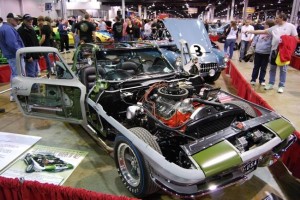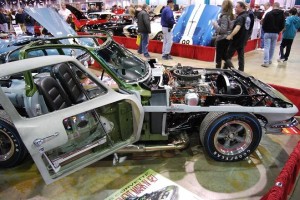By John Gunnell
 In a twist on the “Visible V8” model you may have built as a kid, Kevin Mackay built a visible lifesized ’Vette.
In a twist on the “Visible V8” model you may have built as a kid, Kevin Mackay built a visible lifesized ’Vette.
Then, he made it even more unusual by stuffing it with a famous racing engine that was used in an ultra-rare Corvette racing car that went 180 mph at the 12 Hours of Sebring race in Florida in 1965.
Mackay owns a company called Corvette Repair, Inc., in Long Island, NY. He is well-known for tracking down historic Corvette racing cars that everyone thought were long gone, meticulously restoring them and selling them to big-time collectors.
But the See-Through Midyear Corvette he built is somewhat different.
This Sting Ray coupe with a clear plastic body shell was made for collector Ed Foss to showcase a special Corvette engine he owns.
This power plant is the earliest known example of the 427 cid “Mystery Engine” that engineers Richard L. Keinath, Cal Wade, Denny Davis and Fred Frincke helped develop. Gib Hufstader contributed the first Muncie M-22 “Rock Crusher” transmission to the project. It was the well suited for the massive motor.
 As the story goes, early in 1965, Corvette chief engineer Zora Arkus-Duntov offered the special heavy-duty engine to Delmo Johnson of Johnson Chevrolet in Dallas, TX. Duntov then smuggled it out of the Corvette factory in a convertible that was sent to Johnson who was instructed to put the mill in the Corvette Grand Sport coupe he was campaigning at Sebring.
As the story goes, early in 1965, Corvette chief engineer Zora Arkus-Duntov offered the special heavy-duty engine to Delmo Johnson of Johnson Chevrolet in Dallas, TX. Duntov then smuggled it out of the Corvette factory in a convertible that was sent to Johnson who was instructed to put the mill in the Corvette Grand Sport coupe he was campaigning at Sebring.
David Morgan and Ed Sevadjian were slated to drive the Grand Sport despite the fact that General Motors had a ban on all factory involvement in racing.
The Grand Sport program was ultimately cancelled, but the experimental 427 survived and Kevin Mackay thought the special engine should be showcased in a very special car. He dreamed up the idea of the Visible ‘Vette and the huge crowds it drew at the recent Muscle Car and Corvette Nationals show in Rosemont, IL, showed that his concept was a good one indeed.
Article courtesy of ENGINE BUILDER magazine.













